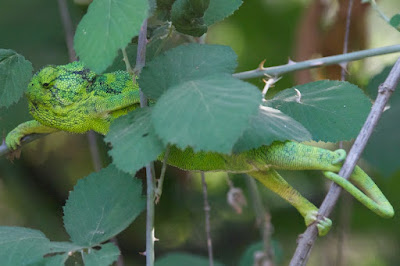For one thing, we found another Common Chameleon (Chamaeleo chamaeleon) here. This one was resplendently green, and easier to spot than the greyish individual we saw at the end of my last post.
Chameleons, of course, are masters of colour change, at least as far as land animals go - they can't hold a candle to a flounder, an octopus or a cuttlefish, mind you. They change for a variety of reasons, including camouflage, temperature regulation, or a desire to impress a rival or potential mate. Why this one has shifted to the bright green end of its colour spectrum I can't say.
Israel is a dry country, but Tel Dan proved surprisingly lush.
This is, of course, because it lies at the source the Dan River, one of the three main tributaries of the Jordan.
The still pools along the river are habitat for aquatic creatures of various sorts, including water striders (Gerridae).
Plant life is relatively rich in the reserve. These impressive acorns belong to the Palestine or Mount Tabor Oak (Quercus ithaburensis).
One rather odd botanical highlight is this hollow but regenerating stump known, for some reason, as Winnie the Pooh's Tree. It is, in fact, a Syrian Ash (Fraxinus syriaca).
Tel Dan is a mixed natural and archaeological site, and to demonstrate that here is (if I have identified it correctly) a member of a genus of plants that has served humans for millenia. Pistacia trees of various species have provided us with everything from resin and turpentine to pistachio nuts. Israel has five native species (not including the commercially-grown P. vera, source of the nuts), and the plants at Tel Dan include hybrids, so I'm not going to go past genus on this one.
This is, probably, also be a Pistacia of sorts.
Readily available water is surely part of the reason that Tel Dan has been occupied since Neolithic times. The part of the reserve in the lower photo has been dubbed "The Garden of Eden", presumably to emphasize its lushness by Israeli standards.
The remains of ancient cities here go back 5000 years, to the Canaanite period (the word "Tel" refers to a mound formed by successive layers of archaeological ruins). This is the Israelite Gate, one of the entrances to the bronze-age city.
The ancient walls, which presumably would have been plastered with dried mud in their heyday, testify to the engineering skills of their builders.
Excavations have been going on since 1966, and have uncovered impressive stretches of wall, well-preserved gates and other artifacts, including a carved stele that may refer to the biblical King David (it seems at least to refer to an Israeli king of some sort, as it includes the words "Melech Yisroel" - King of Israel - evidence, perhaps, of the city's long and often bloody history.























No comments:
Post a Comment